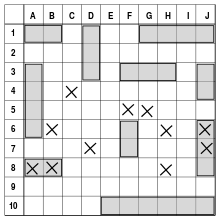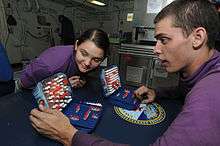Battleship (game)

Battleship (also Battleships or Sea Battle[1]) is a guessing game for two players. It is played on ruled grids (paper or board) on which each players fleet of ships (including battleships) are marked. The locations of the fleets are concealed from the other player. Players alternate turns calling "shots" at the other player's ships, and the objective of the game is to destroy the opposing player's fleet.
Battleship is known worldwide as a pencil and paper game which dates from World War I. It was published by various companies as a pad-and-pencil game in the 1930s, and was released as a plastic board game by Milton Bradley in 1967. The game has spawned electronic versions, video games, smart device apps and a film.
History
The game of Battleship is thought to have its origins in the French game L'Attaque played during World War I, although parallels have also been drawn to E. I. Horseman's 1890 game Baslinda,[2] and the game is said to have been played by Russian officers before World War I.[3] The first commercial version of the game was Salvo, published in 1931 in the United States by the Starex company. Other versions of the game were printed in the 1930s and 1940s, including the Strathmore Company's Combat: The Battleship Game, Milton Bradley's Broadsides: A Game of Naval Strategy and Maurice L. Freedman's Warfare Naval Combat. Strategy Games Co. produced a version called Wings which pictured planes flying over the Los Angeles Coliseum. All of these early editions of the game consisted of pre-printed pads of paper.[2]

In 1967 Milton Bradley introduced a version of the game that used plastic boards and pegs. The method of play involved using pegboards and miniaturized plastic ships, and was thought of by Ed Hutchins. In 1977, Milton Bradley also released a computerized Electronic Battleship,[4] followed in 1989 by Electronic Talking Battleship.[5] In 2008, an updated version of Battleship was released, using hexagonal tiles. In the updated version, each player's board contains several islands on which "captured man" figurines can be placed. Ships may be placed only around the islands, and only in the player's half of the board. When the movie Battleship was released, the board game reverted to the original 1967 style. The 2008 updated version is still available as Battleship Islands.
Battleship was one of the earliest games to be produced as a computer game, with a version being released for the Z80 Compucolor in 1979.[2][6] Many computer editions of the game have been produced since. In Clubhouse Games for the Nintendo DS, Battleship is known as Grid Attack. It is played on an 8×8 grid, and includes slight variations, such as 4-player gameplay, and various ship sizes and shapes. Iterations of Battleship appear as applications on numerous social networking services.
Battleship was also part of Hasbro Family Game Night for the PlayStation 2 and Wii, as well as the Xbox 360 (Xbox Live Arcade). These alter the rules, including the size of the grid (8×12 in the NES version, 8×8 in the Game Boy version), size of ships (it is common to feature a submarine that takes up a single square) and special shot missiles for each ship (for example, in the NES version the cruiser has a 5-shot missile which strikes 5 squares in an X pattern on the grid in one turn. Submarine-tracking sonar and aerial reconnaissance to spot ships are also features).
A minigame version of Battleship was used in the third season of The Hub's Family Game Night, which uses a 5×5 grid and the first team to sink three ships wins the game.
In 2012, the science fiction action movie Battleship was released, which was inspired by the board game. A version of Battleship based on the movie was released in which one side had alien ship playing pieces.
Description

The game is played on four grids, two for each player. The grids are typically square – usually 10×10 – and the individual squares in the grid are identified by letter and number.[7] On one grid the player arranges ships and records the shots by the opponent. On the other grid the player records their own shots.
Before play begins, each player secretly arranges their ships on their primary grid. Each ship occupies a number of consecutive squares on the grid, arranged either horizontally or vertically. The number of squares for each ship is determined by the type of the ship. The ships cannot overlap (i.e., only one ship can occupy any given square in the grid). The types and numbers of ships allowed are the same for each player. These may vary depending on the rules.
The 1990 Milton Bradley version of the rules specify the following ships:[8]
| # | Class of ship | Size |
|---|---|---|
| 1 | Carrier | 5 |
| 2 | Battleship | 4 |
| 3 | Cruiser | 3 |
| 4 | Submarine | 3 |
| 5 | Destroyer | 2 |
In 2002, Hasbro removed the Cruiser, made the Destroyer take 3 squares, and added a new 2-square ship called the Patrol Boat [9]
After the ships have been positioned, the game proceeds in a series of rounds. In each round, each player takes a turn to announce a target square in the opponent's grid which is to be shot at. The opponent announces whether or not the square is occupied by a ship, and if it is a "miss", the opponent player marks their primary grid with a white peg; if a "hit" they mark this on their own primary grid with a red peg. The attacking player notes the hit or miss on their own "tracking" grid with the appropriate color peg (red for "hit", white for "miss"), in order to build up a picture of the opponent's fleet.
When all of the squares of a ship have been hit, the ship is sunk, and the ship's owner announces this (e.g. "You sank my battleship!"). If all of a player's ships have been sunk, the game is over and their opponent wins.
Variations
In the 1931 Salvo edition of the game, players target a specified number of squares at one time, and all of the squares are attacked simultaneously. A player may initially target six squares per turn, and this is decreased as ships are lost.[3] In other variants of this mechanic, the number of shots a player is allowed to fire each turn may either be fixed at five for the whole game, be equal to the number of unsunk ships belonging to the player, or be equal to the size of the player's largest undamaged ship.[2] The receiving player may either call the result of each shot in turn, or simply announce, say, "two hits and three misses", leaving their opponent to work out the consequences of the salvo.[2] In the modern Milton Bradley rules for Battleship, Salvo is listed as a variation "for more experienced players", with the number of shots being equal to the number of ships that the firing player has remaining.[8]
One variant of Battleship allows players to decline to announce that a ship has been sunk, requiring their opponent to take further shots in order to confirm that an area is clear.[2] Another house rule allows a player to move one of their ships to a new, uncalled location every fourth or fifth move.[2]
Another variant of Battleship is the Star Wars version that features space battles between the Rebel Alliance and Galactic Empire.
Type of ship Size Number per player battleship /four-decker /four-funnel 4 1 cruiser /three-decker /three-funnel 3 2 destroyer /two-decker /two-funnel 2 3 submarine /single-decker /single-funnel 1 4
Another variant allows multiple players and allow different shapes for the ships as long as each square of a ship touches at least one other square of that ship. https://www.youtube.com/watch?v=-6U7XKG1Dps
See also
References
- ↑ "Play School Age: Sea Battle a Free Game at Fupa Games". Fupa.com. Retrieved 4 December 2012.
- 1 2 3 4 5 6 7 Hinebaugh, Jeffrey P. (2009). A Board Game Education. R&L Education. ISBN 9781607092605.
- 1 2 "Salvo Is New Game With a Nautical Air". The Milwaukee Journal. 1 July 1931. Retrieved 18 February 2013.
- ↑ "Electronic Battleship". BoardGameGeek.
- ↑ "Electronic Talking Battleship". BoardGameGeek.
- ↑ http://titan.apiit.edu.my/pagol/projectinfo.asp?txtID=TP010249%5Bpermanent+dead+link%5D
- ↑ "Salvo - Complete Rules for Battleships Game".
- 1 2 "Battleship Rules" (PDF). Hasbro. Retrieved 18 February 2013.
- ↑ https://www.hasbro.com/common/instruct/BattleShip_(2002).PDF
External links
| Wikimedia Commons has media related to Battleship (game). |
- Battleship Official Hasbro Rules – Rulebook insert for Battleship (2002 version)
- Battleship at BoardGameGeek
